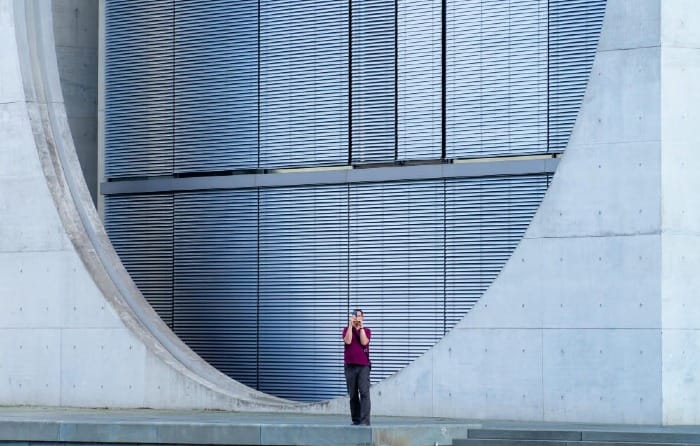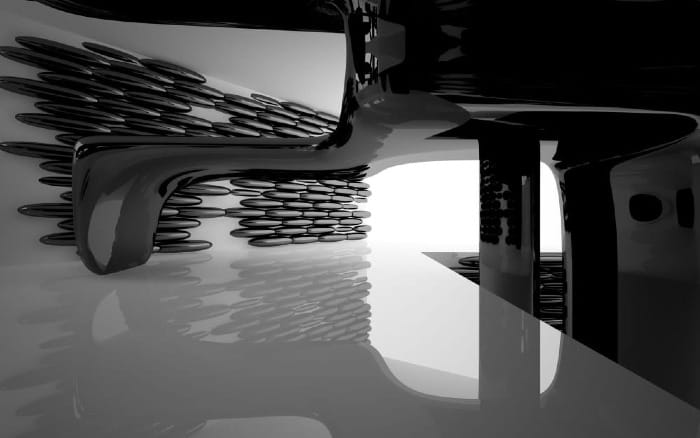Architecture photography captures the beauty and design of buildings and structures. It requires skill and an eye for detail to create visually appealing images. Good composition is key to making architectural photos stand out.
Using a wide-angle lens helps show the bigger picture in architecture photography. This allows photographers to include more of the building and its surroundings in the frame. Wide lenses work well for large structures and interiors.
Composition techniques like the rule of thirds, symmetry, and framing can improve architectural photos. Paying attention to lines, shapes, and textures in buildings also creates stronger images. With practice, photographers can develop their artistic vision to showcase architecture in unique ways.
Understanding the Basics of Composition in Architecture Photography
Composition is key in creating striking architectural photos. It helps highlight a building's unique features and draw viewers' attention to specific elements.
The Rule of Thirds and Balance
The rule of thirds is a fundamental composition technique in architectural photography. Imagine dividing the frame into a 3x3 grid. Place key elements along these lines or at their intersections for a balanced image.
This rule helps create visual interest and guides the viewer's eye through the photo. For example, position a building's entrance or a prominent feature at one of these points.
Balance is also crucial. Distribute visual weight evenly across the frame. This doesn't mean symmetry but rather a harmonious arrangement of elements.
Depth and Dimension in Composition
Adding depth to architectural photos makes them more engaging. Use leading lines to guide the viewer's eye into the image. These could be walkways, staircases, or architectural features.
Foreground elements can create a sense of depth. Include nearby objects or structures to frame the main subject. This technique adds context and scale to the image.
Varying your perspective can also enhance depth. Try shooting from low angles to emphasize a building's height or from high vantage points to showcase its layout.
The Impact of Patterns and Textures
Architecture often features repeating patterns and interesting textures. These elements can add visual interest to your compositions.
Highlight textures by using side lighting to create shadows. This technique brings out the depth and character of materials like brick, stone, or wood.
Patterns can create rhythm in your images. Look for repeating windows, columns, or decorative elements. Frame these patterns to create visually striking compositions.
Use symmetry when present in the architecture. It can create a sense of order and balance in your photos. However, don't be afraid to break symmetry for a more dynamic composition.
Mastering Light and Shadow for Dramatic Effects
Light and shadow are key elements in creating striking architectural photos. They add depth, texture, and mood to images. Photographers can use different lighting techniques to highlight building features and evoke emotions.
Natural Light and The Golden Hour
Natural light offers unique opportunities for architectural photography. The golden hour, just after sunrise or before sunset, bathes buildings in a warm glow. This light creates long, dramatic shadows that emphasize architectural details.
During golden hour, photographers can capture softer contrasts and richer colors. Side lighting at these times reveals textures and shapes. Photographers should position themselves to use the light to create depth and dimension in their compositions.
Cloudy days provide diffused light, reducing harsh shadows. This even lighting can be ideal for capturing intricate details on building facades.
Artificial Lighting and Contrast
Artificial lighting allows photographers to control light and shadow effects. At night, lit buildings stand out against dark skies, creating dramatic scenes.
Photographers can use spotlights to highlight specific architectural features. This technique draws the viewer's eye to important elements.
High contrast between light and dark areas adds drama to images. It can create striking silhouettes or emphasize geometric shapes in modern architecture.
Photographers should experiment with different exposure settings to balance bright and dark areas in artificially lit scenes.
Backlighting and Diffused Light Techniques
Backlighting can create stunning silhouettes of buildings. This technique works well during sunrise or sunset, with the sun behind the structure.
For softer effects, photographers can use diffused light. Sheer curtains or frosted glass can create this light inside buildings.
Diffused light reduces harsh shadows and creates a more even illumination. It's useful for capturing details in shadowy areas of buildings.
Photographers can also use reflectors to bounce light into darker areas. This technique helps balance exposure in high-contrast scenes.
Incorporating the Human Element for Scale and Storytelling

Adding people to architectural photos can make buildings come alive. It helps show size and tell stories about the spaces.
Visual Storytelling with Scale
Including people in architectural photos helps viewers understand building sizes. A person next to a skyscraper shows how tall it is. Someone walking through a doorway reveals its height.
The scale helps tell stories about spaces. A lone figure in a big hall can create a mood of awe or loneliness. A crowd in a plaza shows it's a busy public area.
To use scale well, try different angles and distances. Put people close to key parts of buildings. This guides the eye and creates meaning.
Human Element in Architectural Photography
People bring life to architectural images. They show how spaces are used and enjoyed. A child playing in a park or workers in an office add real-world context.
The human element can create emotional connections. A couple admiring a view or a family entering a home adds warmth to cold structures.
When adding people, think about lighting and placement. Use backlighting to create silhouettes. Position people to lead the eye through the image. This helps viewers explore the whole space.
Remember, people shouldn't overpower the architecture. They should complement it, adding interest without distracting from the building's design.

Choosing the Right Equipment for Architecture Photography
The right gear can make or break your architectural shots. Good equipment helps capture buildings accurately and creatively.
Benefits of Using a Wide-Angle Lens
Wide-angle lenses are crucial for architectural photography. They let photographers capture more of a building in one frame. This is helpful for tight spaces or large structures.
Wide-angle lenses typically have focal lengths between 16-35mm on full-frame cameras. They create a sense of depth and drama in images. These lenses can make spaces look bigger and more impressive.
But wide-angle lenses can cause distortion. Straight lines may appear curved, especially at the edges. Photographers need to be aware of this and correct it if needed.
When to Use a Tilt-Shift Lens
Tilt-shift lenses are specialized tools for architecture photography. They help control perspective and focus planes.

The shift function moves the lens up or down without tilting the camera. This keeps vertical lines straight in tall buildings. It's useful for eliminating converging lines.
The tilt function changes the plane of focus. This lets photographers keep an entire building sharp, even at wide apertures. Tilt-shift lenses are expensive but can produce unique creative effects.
Essential Accessories: Tripod and Remote Release
A sturdy tripod is vital for sharp architectural photos. It keeps the camera steady during long exposures or in low light. Tripods also help with precise framing and composition.

Remote releases prevent camera shake when pressing the shutter button. They're especially useful for long exposures or when using slow shutter speeds.
Photographers can use cable releases or wireless remotes. Some cameras also offer smartphone apps for remote control. These tools help create crisp, blur-free images of buildings and interiors.
Enhancing Architectural Photos with Post-Processing Techniques
Post-processing plays a key role in architectural photography. It helps bring out details, adjust lighting, and create dynamic compositions that showcase structures at their best.
Basic Post-Processing Adjustments
Post-processing for architectural images starts with fundamental adjustments. These include tweaking exposure, contrast, and white balance. Exposure changes can brighten dark areas or tone down overly bright spots.
Contrast adjustments help define edges and textures in buildings. White balance corrections ensure colors look natural and true to life. Cropping can improve composition by removing distractions and focusing on key elements.
Photographers often use lens correction tools to fix distortions common in architectural shots. This keeps vertical lines straight and prevents buildings from looking tilted or warped.
Advanced Techniques for Architectural Edits
More complex edits can take architectural photos to the next level. Selective sharpening enhances textures and details in specific areas without affecting the whole image.
Photographers use layering techniques to blend multiple exposures. This helps balance bright skies with shadowy building details. Perspective correction tools can straighten converging lines, making buildings appear more natural.
Color grading gives photos a cohesive look and feel. It can emphasize the mood or style of the architecture. Removing distractions like power lines or signage helps keep the focus on the building's design.
Advanced editors may use luminosity masks to make precise adjustments to different tonal ranges in the image. This creates photos with greater depth and visual impact.

Exploring Perspectives: Angles, Viewpoints, and Framing
Taking great architectural photos requires careful attention to perspective, angles, and framing. These elements work together to create visually striking images that showcase buildings in unique ways.
The Art of Selecting Viewpoints for Unique Shots
Choosing the right viewpoint is key for capturing stunning architectural images. Look for spots that reveal interesting shapes or patterns in the structure. Try shooting from very low or high vantage points.
A low angle can make buildings appear tall and imposing. High angles show rooflines and overall layouts. Move around to find views that highlight key features.
Don't just shoot from eye level. Climb stairs, use balconies, or lie on the ground for fresh perspectives. Leading lines like roads or walkways can draw the eye through the image.
Framing Architectural Elements Effectively
Framing adds depth and context to architectural photos. Use doorways, arches, or windows as natural frames around your subject. This focuses attention and creates layers.
Trees and foliage can frame buildings in outdoor shots. For interiors, try shooting through partially open doors. Look for repeating shapes that form frames within the architecture itself.
Pay attention to edges. Avoid cutting off important elements. Use the rule of thirds to place key features at strong points in the frame.

Creating Visual Impact with Angles and Perspectives
Creative angles make buildings look dramatic. Tilt the camera for dynamic diagonal lines. Shoot upwards to emphasize height and grandeur.
Wide-angle lenses exaggerate perspective, making spaces look larger. Telephoto lenses compress elements, highlighting patterns and textures.
Play with symmetry and reflections. Capture mirror images in glass or water. Look for interesting shadows that add depth. Experiment with unconventional crops to create abstract views of architectural details.
Discovering Unique Architectural Photography Styles
Architectural photography offers many creative possibilities. Photographers can use different approaches to capture buildings and cityscapes in fresh ways.
Abstract and Minimalist Approaches
Abstract architectural photography focuses on shapes, lines, and patterns. It isolates parts of a building to create striking images. Photographers often use close-ups to highlight textures and materials.
Minimalist styles emphasize clean lines and simple forms. This approach removes distractions and draws attention to key design elements. Photographers may use negative space to create a sense of calm and balance.
Lighting plays a big role in abstract and minimalist shots. Harsh shadows or soft light can change the mood of an image. Black and white photography is popular for these styles. It helps emphasize form and texture.
Capturing Cityscapes with a Wide Lens
Wide-angle lenses are great for cityscape photography. They can fit tall buildings and large urban areas into one frame. This style shows how buildings relate to their surroundings.
Framing techniques are important for wide-angle shots. Photographers use leading lines to guide the viewer's eye through the image. They may include reflections in water or glass to add depth.
The time of day affects cityscape photos. Golden hour light can make buildings glow. Night photography captures city lights and creates a different mood. Long exposures can show movement in the city, like car lights or clouds.
Composition is key in wide-angle cityscapes. Photographers balance foreground and background elements. They may include people or objects to show scale. This helps viewers understand the size of buildings and spaces.

Advanced Composition Strategies for Professional Results
Professional architectural photographers use advanced techniques to create striking images. These strategies help capture the essence of buildings and spaces in unique ways. They go beyond basic composition rules to produce truly memorable photographs.
Creating Mood with Color and Light
Color and light play crucial roles in architectural photography. They set the mood and highlight key features. Photographers often wait for the right time of day to capture ideal lighting conditions.
Golden hour provides warm, soft light that enhances textures. Blue hour creates a magical atmosphere for night shots. Cloudy days offer diffused light, perfect for even illumination.
Photographers use color theory to create visual impact. Complementary colors can make elements pop. Monochromatic schemes convey elegance and simplicity.
Long exposures blur moving elements like clouds or water. This technique adds drama and a sense of time to static structures.
Using Repetition and Rhythm in Composition
Repetition and rhythm are powerful tools in architectural photography. They create visual interest and lead the viewer's eye through the frame.
Repeating elements like windows, columns, or arches form patterns. These patterns can be emphasized through framing and perspective choices.
Photographers use wide-angle lenses to capture expansive views of repeating elements. This technique showcases the scale and grandeur of buildings.
Curved lines and architectural shapes add dynamism to compositions. They break up rigid structures and create flow within the image.
Innovative Approaches to Architectural Photography
Photographers constantly seek new ways to capture buildings. This keeps their work fresh and engaging.
Negative space is used to isolate architectural elements. It draws attention to specific features and creates a sense of scale.
Unconventional angles challenge viewers' perceptions. Low angles make buildings look imposing. High angles reveal hidden patterns and geometries.
Abstract compositions focus on textures, shapes, and details. They transform familiar structures into intriguing visual puzzles.
Reflections in glass or water create symmetry and depth. They add layers of complexity to architectural images.
Thank you for visiting our site and being part of this journey with us! We rely on the generous support of visitors like you to continue providing high-quality. Your donation, no matter the size, helps us maintain the website and create more valuable resources for everyone.


